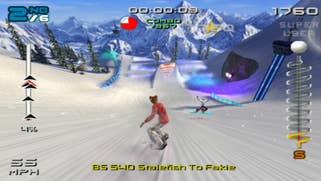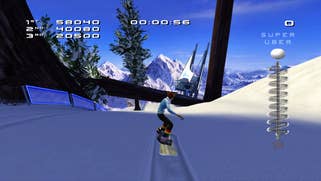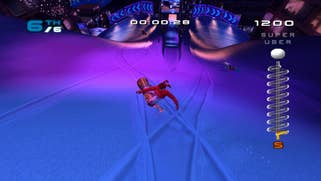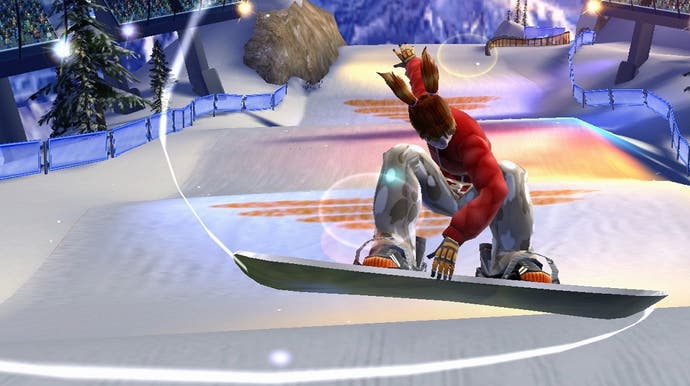SSX 3 is a retro masterpiece - and it's even better on Xbox One
Another unmissable enhanced back-compat release.
With each new generation of consoles, we often wonder - what sort of new gameplay opportunities are made possible with more powerful hardware? It's a difficult question, but the original SSX is one of those few launch games to deliver a satisfying response. With a series of complex, sprawling track layouts, this game simply wouldn't have been possible on previous generation consoles. It's a title defined by its towering tracks, and the increase in available memory and processing power allowed the developers to push the snowboarding genre in new directions. Three years on, EA Canada pushed the formula to its zenith with SSX3, and it's an experience that's now even more special thanks to a new, enhanced iteration for Xbox One and Xbox One X owners.
Before we dive into the new enhancements, let's first step back and appreciate what SSX 3 accomplished way back in 2003. The game launched on PlayStation 2, GameCube and Xbox, offering significant changes compared to the original game. With this third installment, the developers created a pseudo-open world environment that allowed for unprecedented freedom. While you can choose to run individual races, it's also possible to drop your board at the top of a mountain and carve your way all the way to the bottom. A full run from the highest peak to the lowest point requires nearly 30 minutes of continuous play without a single loading screen. It's a revelation.
So how is this achieved? Well, it starts with the building blocks used to create the world. The tracks featured in the SSX series serve up a delicious blend of smooth curves and steep hills. These curves are represented as a grid of bicubic Bezier surfaces - a common technique used in 3D graphics software but still relatively new for real-time 3D in the early 2000s.
This approach enables smoother track design and greater precision when calculating physics. More importantly, using Bezier surfaces helps save memory and performance compared to bespoke vertex geometry, by allowing arbitrary variations in terrain mesh complexity. Basically, rather than storing a bunch of fixed polygonal models, the Bezier grid can be translated into an arbitrary group of triangles at run-time which can then be rendered by the 3D hardware. Using its level of detail system, SSX tessellates between different terrain levels allowing pieces of the stage near the player to appear smoother without rendering the grid at full resolution in the distance. The memory savings resulting from this technique also allow the game to move data in and out of memory as needed, allowing the game to stream level data in real-time. It's this feature that helps make the seamless mountain environment possible.
SSX 3 is also a very colourful game with a huge focus on lighting. The bursts of colour featured throughout the game are derived from light maps - basically, lighting data encoded as 2D textures. While this limits what can be done in real-time (you can't dynamically alter lighting position) this offline approach allows for lights to display far into the distance without any visible pop-in or warping because of grid tessellation. Character models do at least feature multiple light influences as you move down the course. Beyond this, SSX 3 is loaded with rich particle effects and excellent animation lending more personality to its presentation.
In terms of pixel count, the actual rendering resolution ranges from 512x448 on PlayStation 2 to a full 640x480 on the Xbox. And this is where Xbox One comes into play, with a 4x resolution boost to 1280x960 on Xbox One S and a 16x increase on the X, delivering 2560x1920. Widescreen support is included, but this achieved by the emulator stretching the base image horizontally, effectively delivering rectangular pixels. While the image is softened by this process, the result is a game much cleaner than ever before. In fact, at times, the resolution increase is so significant that it highlights flaws in the visuals - the low-resolution skybox doesn't quite hold up at higher resolutions, for example.
The interface itself is also variable - some aspects appear to use vector or even geometry, and so these are rendered properly in high resolution. However, other portions of the user interface utilise low resolution art assets that do not scale well to modern displays. This isn't helped by low quality video sequences which really look poor on Xbox, especially so via emulation, with even the original PlayStation 2 versions looking significantly better. Also curious is that the Xbox version misses a subtle bloom effect present on PS2 - but everything else does see improvement and the new, enhanced version is clearly the best version of the game.
That's all down to performance. SSX 3 is a great-looking game but its performance isn't quite as stable as I would have liked in its original form. On PlayStation 2, the frame-rate is quite variable. Using a double buffer v-sync setup, it bounces between 30 and 60 frames per second, depending on the scene. Most tracks in the game do thankfully hold close to 60fps, with drops from time to time, but the city track at the base of the mountain absolutely wrecks the poor PlayStation 2. The frame-rate suffers badly in this area. The original Xbox version improved performance overall, but the same city area yields the same drop to 30fps - and it's not great. This specific area always bothered me, since it meant that SSX 3 was never a completely smooth experience.
Thankfully, everything has changed on Xbox One. On the X model, SSX 3 now hits and maintains the 60fps target for the vast majority of the duration. There are occasional, very tiny hiccups but it is now locked at 60fps to all intents and purposes. This has a transformative effect on busy sequences, just like that troublesome city track. It really feels great being able to cruise down the mountain without any drops in performance. It goes without saying that the rest of the tracks perform every bit as well. When you combine the high resolution with super stable performance, this is the smoothest SSX has ever been. Frame-rate is hugely important in a game like this - it's just a shame that subsequent SSX sequels opted instead for a disappointing 30fps target.








So how about Xbox One S? Well, in common with many of the OG Xbox titles we've looked at so far, it's very similar to Xbox One X but there are a few more drops here and there that can pop up from time to time. Still, at least the city section runs great on the S and, really, it's still a huge jump over the game running on original hardware.
Frame-rate and resolution aren't the only areas to receive a boost in performance - loading times are another important enhancement. They're actually not bad at all on the original Xbox, but on Xbox One X there are effectively no loading times at all. You can jump in and out of any event almost seamlessly. It's a fantastic improvement - possibly leveraging the RAM disk cache that Microsoft has set up.
So, at this point, it should be clear that SSX 3 looks and runs better than ever before when played on Xbox One and it's another example of a game that once suffered from performance issues on original hardware being pretty much completely fixed. And with these technical issues eliminated, the strong design of the game shines through - its pseudo open world design works beautifully and still holds up today. It works because it offers the benefits of an open world game with the carefully crafted design of a track-based racer. Basically, rather than presenting a giant mountain with a completely open design, SSX 3 instead features a large selection of bespoke, carefully crafted tracks connected by a series of small hubs. You can seamlessly ride from the top to the bottom, but it lacks the aimlessness that is so common in many of today's open world games. It's this combination that allows the game to shine so brightly - it's open world with restraint.
The gameplay loop is focused on completing races across the mountain to unlock new events and earn cash necessary to upgrade your character. While games like Tony Hawk's Pro Skater featured character stats that could be upgraded, the open-ended design of SSX 3 brought a sense of persistence to the experience.
But really, the most important elements here are the controls and the interaction with the slopes and riders. The boards connect beautifully with the environment and feel satisfying to control in a way that competing snowboard games of the era do not. This is enhanced by things like geometric snow trails that vary in thickness depending on how deep the surrounding snow is. There's a weight to the characters that just feels satisfying even compared to modern games like Steep.
Lastly, there is the atmosphere - it's a strange thing to mention in a game like this but SSX 3 manages to perfectly capture the feeling of tranquility. That sensation of carving up a mountain peak with only your music to keep you company is surprisingly effective, even today. This is where the benefits of the pseudo-open world design really shine. During big races, you'll feel the expected energy of competition but when you finish an event and find yourself isolated atop a towering peak, a sense of peace and tranquility washes over you.
This ebb and flow between high-energy action and calm exploration just works perfectly - and that really does effectively sum up the SSX 3 experience. It's a delicate blend of elements that all work together to create a cohesive whole. That we can now experience with the game on modern hardware with its few blemishes entirely erased only helps further cement its place in history. If you have an Xbox One and enjoy racing games to any degree, SSX 3 is well worth revisting.










